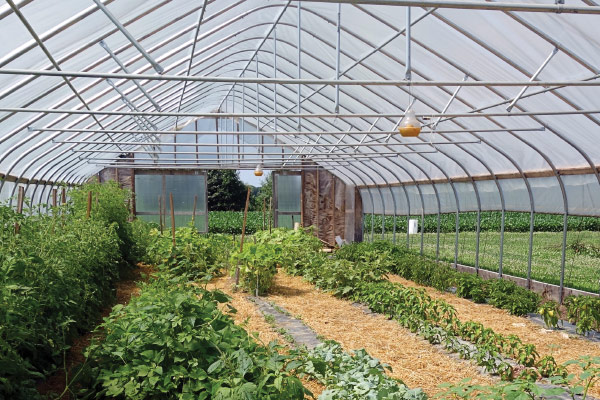All About Pests in High Tunnels for the Beginning Farmer
 |
|
Trap in high tunnel. Photo provided by Rose Ogutu. |
Many growers in Delaware who use high tunnels and small-acreage fields turn to cultural, mechanical, physical, and biologically-based methods of pest management first before they determine whether chemical control methods are needed, if at all. Growers are often very enthusiastic about high tunnels as tools that extend the season and confer better pest management compared to field production. The high tunnels managed by our Delaware small farmers are mainly acquired with the help of the Natural Resources Conservation Services Environmentally Quality Incentives Program (NRCS-EQIP). As per the program’s requirement, beginning farmers start using high tunnels immediately, hence the need for IPM training.
Lately, the perspective on management of pests (insects, diseases, and weeds) by beginning farmers is laced with awareness and concerns about food safety and environmental issues. The major intent is to maintain an allowable threshold of pests hence the avoidance of harsh or excessive chemicals while getting ample production. Balancing the two scenarios is crucial and leaves our target group of beginning farmers clamoring for information on alternatives to pesticides. Extension literature lacks reports on multi-site, multi-year and multi-product tests for the products deemed to be safe for use, hence the need for IPM. The reality is that in instances of overwhelming occupancy of pests, growers resort to harsh chemicals to eliminate them, but this is not a sustainable approach.
When growers begin to think at the systems level, they soon ask questions, like: “How do I efficiently manage pests in the high tunnel? How do I combine cultural, mechanical, biological and chemical ways in appropriate proportions to help manage pests in a high tunnel? Do the methods follow any order of priority or practice?”
The extended season of production in high tunnels presents a longer time of plant production thereby attracting pests over a longer period necessitating the need for high-level IPM. Early detection is very important. Scouting is encouraged and growers ought to be able to identify most of the common high tunnel pests that include aphid, whitefly, mite, hornworm, cucumber beetle, flea beetle, slug, cabbage looper, as well as diseases such as powdery mildew, blight, and wilt. Insect monitoring includes the use of traps, and yellow and blue sticky cards. The design of the high tunnel and orientation of planting in high tunnels help eliminate high temperature and high humidity. It is generally helpful to monitor moisture levels in a high tunnel since the structure excludes rainfall and traps moisture inside.
Other critical practices for high tunnel growers using an IPM approach include:
Cultural. Incorporate varieties of disease-resistant plant types and maintain sanitation within and around the high tunnel. Schedule harvest of crops early enough before pest populations hit. Vertical plants use high tunnel space efficiently but need adequate trellising and timely pruning. Practice crop diversity, crop rotation, including banker plants, and keenly manage watering mainly through drip irrigation and fertigation. Conduct weed control using mulches—black plastic, straw, and landscape fabric.
Mechanical/Physical. Manage and scout spaces under high tunnels. Sizable pests can be squashed by the grower. Orient the plants and spaces to create an environment unfavorable to disease development through ventilation for temperature and humidity regulation. Use shading nets for heat management and netting materials and screen doors for pest exclusion. Exposing the high tunnel to the very low temperatures in the winter helps slow down pest outbreaks at the beginning of the planting season.
Biological. The release of bio-agents in high tunnels helps manage pests. The environment in the high tunnel should support the prevalence of the bio-agent. Use cover crops (flax, marigold, pearl millet) as bio-fumigants. Banker plants encourage the presence of beneficial predatory insects.
Chemical. In most cases, growers may use chemicals recommended for the greenhouse, as high tunnels are also enclosures. Always read the label and follow instructions. Treatment of localized pest outbreaks helps avoid unnecessary use of chemicals elsewhere in the high tunnel. Keep spray records to help gauge effectiveness.
High tunnels create an environment that is a hybrid between the field (environmentally uncontrolled) and a functional greenhouse (controlled environment). More research on biological and chemical pest control is needed. Holistic IPM regimes need to be developed for beginning and established farmers who are growing popular high tunnel crops.
— Rose Ogutu, Delaware State University
The Northeastern IPM Center promotes integrated pest management for reducing risks to human health and the environment. If republishing our news, please acknowledge the source (“From Northeast IPM Insights”) along with a link to our website.
